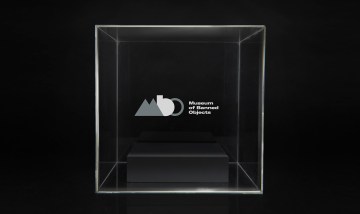
One way futurists expand our thinking is through the creation of immersive scenarios: physical embodiments of possible futures. In one of my favorite examples, futurist Jake Dunagan installed “Mayor’s Office, 2061” in a former garage to explore what it would be like to live and work in a Newport shaped by trends ranging from cloning to climate change. Recently I interviewed artists Ellie Sachs and Matt Starr, creators of an immersive scenario presented as an exhibit. The Museum of Banned Objects, a collaboration between the artists and Planned Parenthood, is on display at ACE Hotel in New York City until May 5th.
Me: Ellie and Matt, what specific future do you explore in this installation?
E&M: The exhibit posits a not-so-distant dystopian future where reproductive health products have been banned and are out of circulation. We think this is a plausible future, in light of significant restrictions and cuts that have been made to funding for and access to reproductive health services. We hope it provokes viewers to consider the very nature of resistance, equality, and hegemony. As a whole, the piece works as a forewarning: creating a reality in order to avoid another possible reality.
Me: Can you describe the installation for readers?
E&M: Museum of Banned Objects includes eight reproductive health and contraceptive products on display in glass vitrines. Museum placards explain the significance of each item and are written in past tense to signify the items being banned and out of circulation. (Readers can visit a digital version of the exhibit online.) At its core, the piece is an exercise in futurism: creating an interactive world in which the viewer can fully immerse themselves.
Me: You partnered with Planned Parenthood on the exhibit. Tell me a bit about that collaboration.
E&M: Once the idea was solidified on our end, we reached out to Caren Spruch, who heads up Arts and Entertainment Engagement at Planned Parenthood. Caren was excited about the idea and she and her team began working with us pretty quickly. We think the idea appealed to Planned Parenthood for a number of reasons; perhaps most pertinently on Planned Parenthood’s end, it boils down to the way we describe the intention behind this exhibit “creating a reality in order to avoid another possible reality.” And, as Caren put it for an interview with The Guardian, “Art can drive social change and help shape a world that is fairer and more just by powering awareness, defiance, resistance, and change. We appreciate Sachs and Starr’s work to use their passion and creativity to resist and bring attention to protecting access to birth control for everyone.”
Further, Planned Parenthood is no stranger to partnering with artists to further their message of accessible healthcare and reproductive justice for all. Projects like the immersive virtual reality experience Across the Line, which focuses on abortion in America, and Planned Parenthood’s frequent art auctions advance their cause in significant ways while adding to culture.
Our collaboration with Planned Parenthood centered most significantly on historical accuracy and language. It was important for us to be using the most precise scientific language and to frame the exhibit with inclusive language.

Me: Why did you decide to install the museum in the Ace Hotel, and how has that worked out?
E&M: We reached out to the ACE soon after Planned Parenthood came on board. We were drawn to showing the piece in a public space so as many people as possible could engage with the exhibit. ACE’s lobby area blurs the lines between guests, freelancers, and curious people who feel like popping in. We were attracted to the large swath of people that pass through ACE, as visibility has been an important tenet in creating this piece. Plus, the ACE already has a great history of partnering with artists in their gallery space so we felt confident going into it. We’ve enjoyed our collaboration with them and we think it’s been beneficial for them as well (in terms of press, foot traffic, and engagement.)
Me: You chose this topic in part because it is controversial—because we as a society are trying to figure out what we want the future to be when it comes to reproductive rights. What has the reaction been?
E&M: Absolutely. On the whole, the reaction of staff and guests has been positive. There hasn’t been any overtly negative feedback, but perhaps that’s also due in part to our location (liberal, coastal city). We don’t have a way for guests to leave feedback, but perhaps that’s something we could be open to in future iterations.
Me: What’s next—will the museum pop-up in another location?
E&M: While the initial venue has been a strong first step, we’re interested in finding a partner that has the resources and space to help us expand our vision. Ideally, we’d like the opportunity to create some programming around the event and share the world we’ve created with a diverse audience. Further, we’re looking to work with an organization that is accessible to the public, and is passionate about helping us build out the world of the exhibit further. On a practical level, more space would be ideal. The current space at ACE hotel is roughly 15 ft x 15 ft, but a larger room would be a better fit for this project.
We would be incredibly excited to work with a partner on a slightly different iteration of the piece, and to create more programming and community engagement.
If any of your readers are interested in talking to us about hosting the Museum of Banned Objects, they can reach us at sachsandstarr (at) gmail.com
In addition to visiting the Museum of Banned Objects online, you can read about the installation in The Guardian, Vanity Fair, and The Washington Post. You can follow Ellie and Matt on Instagram @esachsy and @mattstarrmattstarr








